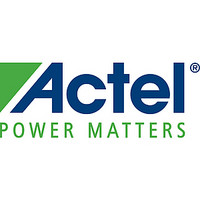AGLN250V2-ZCSG81 Actel, AGLN250V2-ZCSG81 Datasheet - Page 7

AGLN250V2-ZCSG81
Manufacturer Part Number
AGLN250V2-ZCSG81
Description
Manufacturer
Actel
Datasheet
1.AGLN060V2-ZVQG100I.pdf
(132 pages)
- Current page: 7 of 132
- Download datasheet (5Mb)
†
The AGLN030 and smaller devices do not support PLL or SRAM.
Unlike SRAM-based FPGAs, the device does not need to reload configuration and design state from
external memory components; instead it retains all necessary information to resume operation
immediately.
Reduced Cost of Ownership
Advantages to the designer extend beyond low unit cost, performance, and ease of use. Unlike
SRAM-based FPGAs, flash-based IGLOO nano devices allow all functionality to be live at power-up;
no external boot PROM is required. On-board security mechanisms prevent access to all the
programming information and enable secure remote updates of the FPGA logic. Designers can
perform secure remote in-system reprogramming to support future design iterations and field
upgrades with confidence that valuable intellectual property cannot be compromised or copied.
Secure ISP can be performed using the industry-standard AES algorithm. The IGLOO nano device
architecture mitigates the need for ASIC migration at higher user volumes. This makes IGLOO nano
devices cost-effective ASIC replacement solutions, especially for applications in the consumer,
networking/communications, computing, and avionics markets.
With a variety of devices under $1, Actel IGLOO nano FPGAs enable cost-effective implementation
of programmable logic and quick time to market.
Firm-Error Immunity
Firm errors occur most commonly when high-energy neutrons, generated in the upper atmosphere,
strike a configuration cell of an SRAM FPGA. The energy of the collision can change the state of the
configuration cell and thus change the logic, routing, or I/O behavior in an unpredictable way.
These errors are impossible to prevent in SRAM FPGAs. The consequence of this type of error can be
a complete system failure. Firm errors do not exist in the configuration memory of IGLOO nano
flash-based FPGAs. Once it is programmed, the flash cell configuration element of IGLOO nano
FPGAs cannot be altered by high-energy neutrons and is therefore immune to them. Recoverable
(or soft) errors occur in the user data SRAM of all FPGA devices. These can easily be mitigated by
using error detection and correction (EDAC) circuitry built into the FPGA fabric.
Advanced Flash Technology
The IGLOO nano device offers many benefits, including nonvolatility and reprogrammability,
through an advanced flash-based, 130-nm LVCMOS process with seven layers of metal. Standard
CMOS design techniques are used to implement logic and control functions. The combination of
fine granularity, enhanced flexible routing resources, and abundant flash switches allows for very
high logic utilization without compromising device routability or performance. Logic functions
within the device are interconnected through a four-level routing hierarchy.
IGLOO nano FPGAs utilize design and process techniques to minimize power consumption in all
modes of operation.
Advanced Architecture
The proprietary IGLOO nano architecture provides granularity comparable to standard-cell ASICs.
The IGLOO nano device consists of five distinct and programmable architectural features
(Figure 1-3 on page 1-5
The FPGA core consists of a sea of VersaTiles. Each VersaTile can be configured as a three-input
logic function, a D-flip-flop (with or without enable), or a latch by programming the appropriate
flash switch interconnections. The versatility of the IGLOO nano core tile as either a three-input
lookup table (LUT) equivalent or a D-flip-flop/latch with enable allows for efficient use of the FPGA
fabric. The VersaTile capability is unique to the Actel ProASIC
•
•
•
•
•
•
Flash*Freeze technology
FPGA VersaTiles
Dedicated FlashROM
Dedicated SRAM/FIFO memory
Extensive CCCs and PLLs
Advanced I/O structure
to
Figure 1-4 on page
†
A dv a n c e v 0. 8
†
1-5):
®
IGLOO nano Device Overview
family of third-generation-
1 - 3
Related parts for AGLN250V2-ZCSG81
Image
Part Number
Description
Manufacturer
Datasheet
Request
R

Part Number:
Description:
AGLN250V2-CSG81
Manufacturer:
Actel
Datasheet:

Part Number:
Description:
AGLN250V2-CSG81I
Manufacturer:
Actel
Datasheet:

Part Number:
Description:
PQFP 100/FPGA, 6144 CLBS, 250000 GATES, 250 MHz
Manufacturer:
Actel
Datasheet:

Part Number:
Description:
Manufacturer:
Actel
Datasheet:

Part Number:
Description:
Manufacturer:
Actel
Datasheet:

Part Number:
Description:
FPGA - Field Programmable Gate Array 250K System Gates IGLOO nano
Manufacturer:
Actel
Datasheet:

Part Number:
Description:
FPGA - Field Programmable Gate Array 250K System Gates IGLOO nano
Manufacturer:
Actel
Datasheet:

Part Number:
Description:
FPGA - Field Programmable Gate Array 250K System Gates IGLOO nano
Manufacturer:
Actel
Datasheet:

Part Number:
Description:
MCU, MPU & DSP Development Tools IGLOO nano Starter Kit
Manufacturer:
Actel
Datasheet:

Part Number:
Description:
MCU, MPU & DSP Development Tools Silicon Sculptor Programming Mod
Manufacturer:
Actel

Part Number:
Description:
MCU, MPU & DSP Development Tools InSystem Programming ProASICPLUS Devices
Manufacturer:
Actel

Part Number:
Description:
Programming Socket Adapters & Emulators PQ160 Module
Manufacturer:
Actel

Part Number:
Description:
Programming Socket Adapters & Emulators Axcelerator Adap Module Kit
Manufacturer:
Actel

Part Number:
Description:
Programming Socket Adapters & Emulators Evaluation
Manufacturer:
Actel

Part Number:
Description:
Programming Socket Adapters & Emulators AFDX Solutions
Manufacturer:
Actel










